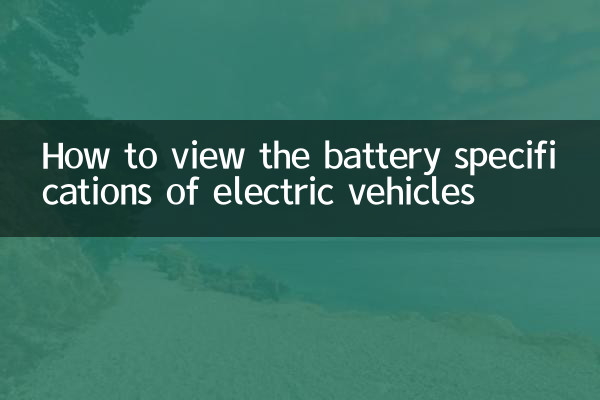How to view the battery specifications of electric vehicles
With the popularity of electric vehicles, the specifications and parameters of batteries, as core components, directly affect the performance and user experience of the vehicle. However, many consumers are often confused when facing battery specifications. This article will structure the analysis of the key parameters of electric vehicle batteries to help you quickly grasp the key points of purchase.
1. Analysis of core parameters of electric vehicle batteries

The battery specification mainly includes the following 6 key indicators, which together determine the battery life, power and life:
| Parameter name | unit | Description of function | Typical Value Example |
|---|---|---|---|
| Rated capacity | Ah (Anshi) | The main indicators that determine battery life | 20Ah/30Ah/50Ah |
| Voltage | V (volt) | Affects the motor power output | 48V/60V/72V |
| Energy density | Wh/kg | Energy storage capacity per unit weight | 180-250Wh/kg |
| Cyclic life | Second-rate | Complete charge and discharge times | 800-2000 times |
| Charging temperature range | ℃ | Safe use temperature | 0-45℃ |
| Battery Type | - | Material system differences | Lead acid/triple lithium/lithium iron phosphate |
2. Comparison of different types of batteries
Currently, mainstream electric vehicle batteries can be divided into three categories, each with the following characteristics:
| Battery Type | advantage | shortcoming | Applicable car models |
|---|---|---|---|
| Lead acid battery | Low price and high stability | Large weight and short life | Low-end scooter |
| Triple lithium battery | High energy density | Poor high temperature stability | Mid-to-high-end models |
| Lithium iron phosphate battery | Long life and good safety | Weak low temperature performance | Commercial/high-end models |
3. How to calculate the actual battery life?
The theoretical range can be estimated through the battery specifications, and the calculation formula is:
Climate range (km) = battery capacity (Ah) × voltage (V) × energy efficiency coefficient ÷ power consumption per 100 kilometers
The energy efficiency coefficient is usually 0.7-0.9, and the reference value of power consumption per 100 kilometers for different models:
| Car model | Power consumption per 100 kilometers (kWh) |
|---|---|
| Electric bicycle | 1.0-1.5 |
| Electric motorcycle | 2.0-3.0 |
| Electric cars | 12-18 |
4. Purchase suggestions
1.Daily commuting: Choose a capacity of more than 40Ah, lithium iron phosphate batteries are safer and more durable
2.Long-distance demand3.Northern Users: Pay attention to low-temperature discharge performance, ternary lithium batteries can still maintain 70% capacity at -20℃
4.A choice of cost-effective: Although the lead-acid battery pack is bulky, the replacement cost is only 1/3 of that of lithium batteries.
5. Latest industry trends
According to recent hot spot monitoring, there are three breakthroughs in the field of battery technology that are worth paying attention to:
• CATL released a Shenxing battery with a 10-minute charging range of 400 kilometers
• BYD blade battery energy density exceeds 190Wh/kg
• The cost of sodium ion batteries is 30% lower than that of lithium batteries, and they are about to be mass-produced and installed in vehicles.
Mastering these battery specification knowledge will not only help you choose the right electric car, but also avoid being misled by bad merchants during later maintenance. It is recommended that consumers require the merchant to provide a complete battery parameter inspection report when purchasing, and purchase original batteries through formal channels to ensure safety.

check the details

check the details